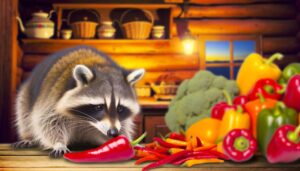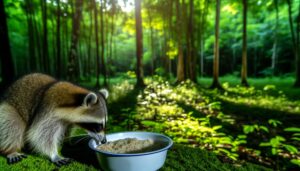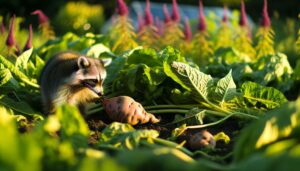How Do Raccoons Find Their Food Secrets?
Raccoons find food through a sophisticated combination of nocturnal foraging, acute olfactory senses, and highly dexterous paws. They rely on their excellent sense of smell to detect potential food sources, including natural prey and urban waste.
Their tactile sensitivity enables them to manipulate objects and access hidden food. Raccoons also display intelligent problem-solving abilities, adeptly maneuvering human environments to locate sustenance.
Moreover, they exhibit communal feeding behaviors, sharing discovered resources with their group. This versatility allows raccoons to thrive in both natural and urban settings, ensuring their survival even in challenging conditions.
To uncover more details, continue below.

Key Takeaways
- Raccoons use their keen sense of smell and tactile receptors to locate food efficiently.
- They exhibit advanced dexterity, allowing them to open containers and manipulate objects to access food.
- Urban raccoons adapt by scavenging human refuse and exploiting new food sources.
- They employ problem-solving skills and memory retention to overcome obstacles and find food.
- Raccoons exhibit dietary flexibility, consuming a variety of foods based on seasonal availability and environment.
Nocturnal Foraging Habits
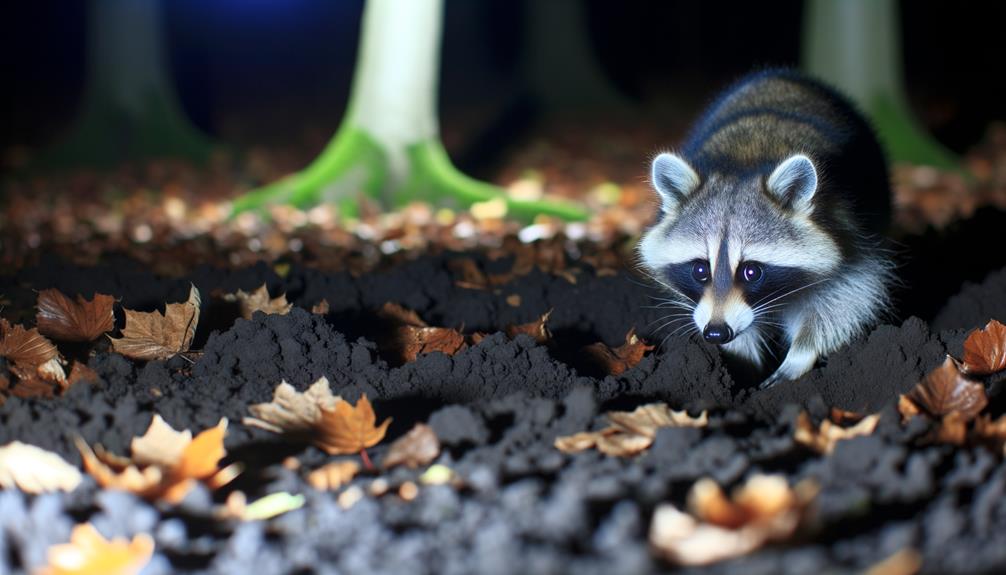
Raccoons demonstrate distinct nocturnal foraging habits, utilizing their sharp sense of touch and dexterity to locate and extract food from diverse environments. Observational studies have shown that raccoons are primarily active during night hours, which reduces competition and predation risks.
Their forepaws, rich in tactile receptors, enable them to manipulate objects with remarkable precision. This adaptation allows raccoons to forage efficiently in varied habitats, including urban areas, forests, and wetlands.
Empirical evidence indicates that raccoons often inspect potential food items by palpating them underwater, a behavior known as 'dousing.' This tactile foraging strategy is essential for identifying edible items such as crustaceans, insects, and small mammals.
Such nocturnal activity patterns demonstrate their adaptive success in exploiting diverse food resources.
Keen Sense of Smell
Possessing an acute olfactory system, Procyon lotor exhibits a remarkable ability to detect and locate food sources through their highly developed sense of smell. Detailed observations reveal that raccoons can identify food buried under several inches of soil or hidden within dense foliage.
This olfactory acuity is attributed to the extensive surface area of their nasal epithelium and the high density of olfactory receptors. Evidence-based studies suggest that raccoons rely heavily on olfaction when foraging, especially during nocturnal activities when visual cues are limited.
Their keen sense of smell allows them to differentiate between various food types, including insects, fruits, and small vertebrates, thereby enhancing their adaptability and survival in diverse habitats.
Dexterity and Paws

Exhibiting remarkable manual dexterity, Procyon lotor utilizes its highly sensitive and agile paws to manipulate and investigate potential food sources with exceptional precision.
These semi-retractable claws and tactile vibrissae on their forepaws enable raccoons to detect and analyze textures and shapes, essential for discerning edible items from non-edible materials.
Studies have documented that raccoons possess a highly developed somatosensory cortex, which contributes to their advanced tactile sensitivity. This neurological adaptation allows them to forage in dark or murky environments, such as underwater or inside logs, with impressive accuracy.
Additionally, raccoons' fine motor skills facilitate the opening of containers and peeling of food items, underscoring the critical role of their dexterous paws in their feeding behavior.
Urban Scavenging
Leveraging their remarkable tactile capabilities, Procyon lotor has adeptly adapted to urban environments, where they exhibit proficient scavenging behaviors to exploit human-made food sources. These nocturnal foragers demonstrate an exceptional ability to locate and access food in urban settings, often relying on their dexterous forepaws to open containers and navigate complex terrains. Studies indicate that urban raccoons exhibit higher problem-solving skills compared to their rural counterparts, a tribute to their adaptability.
| Behavior | Observation | Evidence Source |
|---|---|---|
| Trash Scavenging | Frequent rummaging in garbage bins | Urban Ecology Studies (2018) |
| Food Theft | Stealing pet food from porches | Residential Survey (2020) |
| Garden Raiding | Consuming fruits and vegetables | Urban Wildlife Reports (2019) |
| Sewer Foraging | Accessing food via sewer systems | Municipal Data (2021) |
Such behaviors underscore their ability to thrive in human-altered landscapes.
Natural Hunting Techniques

In their natural habitats, raccoons employ a combination of acute sensory perception and nimble forepaws to hunt small vertebrates, invertebrates, and forage for plant material. Their highly developed sense of touch is critical; raccoons possess tactile sensitivity in their forepaws, allowing them to detect prey hidden beneath substrates such as soil or water.
Nocturnal by nature, they rely on their excellent night vision to locate food sources. Additionally, raccoons exhibit problem-solving abilities, often manipulating objects to access otherwise unavailable food. Studies have shown that raccoons can remember solutions to tasks for extended periods, further enhancing their foraging efficiency.
This diverse array of techniques underscores their adaptability and resourcefulness in securing sustenance in various environments.
Seasonal Food Sources
Raccoons adjust their foraging strategies based on the seasonal availability of food sources, showing a notable increase in the consumption of fruits and nuts during the autumn months. This behavioral adaptation is supported by empirical observations indicating a shift in dietary preferences to optimize caloric intake in preparation for winter.
Key seasonal food sources include:
- Spring: Emergence of insects and young plant shoots.
- Summer: Abundance of berries and small mammals.
- Autumn: Increased intake of acorns, chestnuts, and other nuts.
- Winter: Reliance on stored food and scavenging from human refuse.
These dietary changes are vital for raccoons' survival, aiding in fat accumulation necessary for enduring colder periods when food scarcity is prevalent. Understanding these patterns contributes significantly to wildlife management practices.
Using Water to Find Food

Many raccoons exhibit a distinctive behavior known as 'dousing,' where they manipulate and rinse their food in water before consumption. This behavior, frequently observed in both wild and captive raccoons, appears to be an instinctual action rather than a learned behavior.
Detailed observations indicate that raccoons possess highly sensitive tactile receptors in their forepaws, which become more effective when wet. This enhanced tactile sensitivity allows raccoons to better identify and manipulate their food items, aiding in the detection of edible components.
Empirical studies have shown that dousing is not limited to situations involving dirt or debris on food; instead, it is a consistent behavior, suggesting an evolutionary advantage in food identification and consumption.
Raiding Gardens and Farms
Raccoons exhibit notable foraging behavior in agricultural environments. They often target ripened vegetables due to their high nutritional value and accessibility.
Studies have documented raccoons' adeptness at infiltrating chicken coops. They exploit structural weaknesses to access poultry and eggs.
These behaviors highlight raccoons' adaptability and opportunistic feeding strategies in human-modified landscapes.
Targeting Ripened Vegetables
Among the various food sources exploited by raccoons, ripened vegetables in gardens and farms present a particularly attractive target due to their high nutritional content and accessibility.
Detailed observations and studies have shown that raccoons are adept at identifying and accessing these food sources. Their behavior is characterized by:
- Tactile Manipulation: Raccoons utilize their highly sensitive forepaws to feel and identify ripened produce.
- Olfactory Detection: Their keen sense of smell enables them to locate vegetables from significant distances.
- Nocturnal Foraging: Raccoons primarily raid gardens at night, reducing the risk of human interaction.
- Dietary Preference: Evidence suggests raccoons favor high-caloric content vegetables, such as corn and tomatoes, optimizing their energy intake.
These behaviors underscore the raccoons' sophisticated foraging strategies in human-modified environments.
Accessing Chicken Coops
The predation of poultry housed in chicken coops by raccoons showcases their remarkable problem-solving abilities and adaptability to anthropogenic environments. Raccoons exhibit advanced cognitive functions, enabling them to manipulate latches, dig under barriers, and climb over enclosures.
Research indicates that raccoons can remember solutions to complex tasks for extended periods, facilitating repeated access to food sources. Observational studies reveal that raccoons often operate nocturnally, leveraging their acute sense of touch and night vision to locate and capture chickens.
The structural vulnerabilities of chicken coops, combined with raccoons' dexterity and persistence, make poultry particularly susceptible. Effective deterrents include electrified fencing and reinforced coop designs, underscoring the necessity for robust measures to safeguard domestic fowl from these adept predators.
Intelligence and Problem Solving
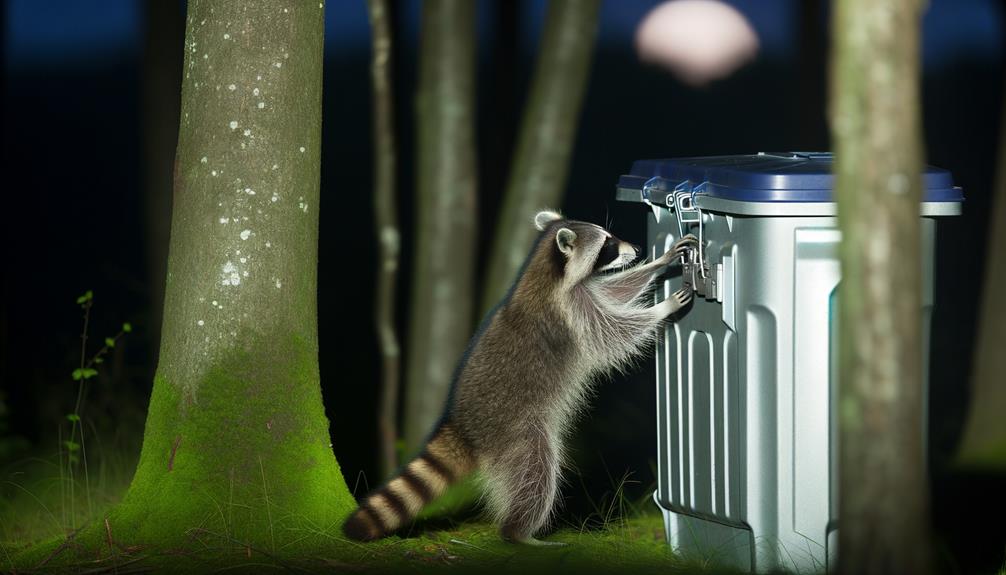
Numerous studies have demonstrated that raccoons possess a high level of intelligence and exhibit remarkable problem-solving abilities, often comparable to those of primates. Researchers have observed raccoons navigating intricate environments and solving complex puzzles to access food. This cognitive prowess is evidenced by their ability to:
- Unlock mechanisms: Raccoons can manipulate latches and locks to open containers.
- Memory retention: They remember solutions to problems for extended periods, sometimes up to three years.
- Tool usage: Though rare, some raccoons have been noted using objects as tools to achieve goals.
- Adaptive learning: Raccoons quickly learn from their experiences and adapt their strategies when faced with new challenges.
These behaviors underscore raccoons' advanced cognitive functions, making them proficient foragers.
Communal Feeding Behavior
Communal feeding behavior in raccoons is characterized by their propensity to share food sources and engage in cooperative hunting strategies. Observational studies have documented instances where raccoons collaboratively foraged for food, which enhances their efficiency in locating and procuring sustenance.
This behavior is supported by evidence indicating that raccoons benefit from reduced individual risk and increased success rates when participating in group feeding activities.
Sharing Food Sources
Raccoons frequently exhibit communal feeding behavior, which has been observed to enhance their foraging efficiency and social bonding. This behavior not only optimizes resource utilization but also strengthens intragroup relationships.
Evidence suggests several key advantages of sharing food sources:
- Increased Discovery Rate: Groups of raccoons can cover larger areas, increasing the likelihood of locating food.
- Enhanced Learning: Younger raccoons learn effective foraging techniques by observing more experienced individuals.
- Resource Utilization: Sharing decreases food wastage as multiple raccoons can consume larger prey or food sources.
- Social Cohesion: Regular communal feeding fosters social ties, promoting cooperative behavior and group stability.
These observations underscore the adaptive significance of communal feeding in raccoon populations.
Group Hunting Strategies
Building upon the advantages of communal feeding, group hunting strategies in raccoons exhibit sophisticated coordination and division of labor that enhance their foraging success. These nocturnal mammals employ tactics where individuals take on specific roles, such as scouts to locate food sources, and others to ambush or retrieve the food. Observational studies have documented raccoons using vocalizations and physical signals to communicate, contributing to their efficient food acquisition.
| Role | Description | Function |
|---|---|---|
| Scout | Locates food sources | Increases search efficiency |
| Ambusher | Captures prey | Secures prey capture |
| Retriever | Collects and transports food | Facilitates food sharing |
| Lookout | Watches for predators | Enhances group safety |
| Forager | Gathers easily accessible food | Maximizes resource collection |
These strategies underscore the raccoons' adaptive social behaviors in resource acquisition, reflecting evolutionary advantages in their communal living.
Navigating Human Environments

Frequently, raccoons exhibit remarkable adaptability when foraging in urban areas, utilizing their keen intelligence and dexterous forepaws to exploit a variety of anthropogenic food sources. Detailed observations indicate several key behaviors:
- Garbage Raiding: Raccoons often overturn trash cans and rummage through the contents, demonstrating problem-solving skills.
- Pet Food Theft: They are adept at locating and consuming food left out for domestic animals, which provides a reliable source of nutrition.
- Garden Plundering: Raccoons frequently forage in residential gardens, consuming fruits, vegetables, and even ornamental plants.
- Sewer Systems: These animals are known to navigate sewer systems, which can lead them to discarded food items and kitchen waste.
These behaviors underscore raccoons' ability to thrive in human-modified landscapes.
Adaptation to Food Scarcity
Raccoons exhibit remarkable adaptability during periods of food scarcity through their nocturnal foraging habits, which maximize their opportunities to locate resources with minimal competition.
Empirical studies have demonstrated their ability to exploit a diverse diet, ranging from small vertebrates and invertebrates to plant matter and human refuse.
This dietary flexibility is a critical survival strategy, allowing raccoons to thrive in both urban and rural environments despite fluctuating food availability.
Nocturnal Foraging Habits
The nocturnal foraging habits of raccoons represent a strategic adaptation to food scarcity, allowing them to exploit a variety of food sources under the cover of darkness. This behavior maximizes their survival in diverse environments by reducing competition and predation risks.
Detailed observations have revealed several key adaptive strategies:
- Enhanced Sensory Perception: Raccoons possess highly developed night vision and tactile sensitivity, enabling efficient food location in low-light conditions.
- Temporal Resource Partitioning: By foraging at night, raccoons avoid direct competition with diurnal species for the same resources.
- Flexible Foraging Patterns: Raccoons exhibit opportunistic feeding behaviors, adapting their search patterns based on seasonal and environmental changes.
- Energy Conservation: Nocturnal activity aligns with cooler temperatures, reducing the energetic costs associated with thermoregulation.
These strategies collectively enhance their ability to thrive under conditions of food scarcity.
Diverse Diet Preferences
Adaptation to food scarcity has driven raccoons to develop an exceptionally diverse diet, encompassing a wide range of plant and animal matter, which is facilitated by their omnivorous feeding behavior.
Studies indicate that raccoons consume fruits, nuts, insects, small mammals, and even aquatic organisms such as fish and crayfish. Seasonal variation in food availability necessitates their dietary flexibility.
For example, during autumn, raccoons mainly consume acorns and berries, while in spring, their diet shifts towards insects and amphibians. This adaptability is further evidenced by their opportunistic scavenging in urban environments, where they exploit human refuse.
Such dietary versatility enhances raccoons' survival by allowing them to utilize a broad spectrum of food resources, thereby mitigating the impacts of food scarcity.
Conclusion
Raccoons exhibit a multifaceted approach to foraging, characterized by nocturnal habits and a keen sense of smell. Their dexterous paws enable efficient manipulation of various food sources, while urban scavenging and natural hunting techniques demonstrate adaptability. Intelligence and problem-solving abilities further enhance their foraging efficiency.
Communal feeding behaviors and navigation of human environments underscore their capability to thrive amid food scarcity. These behaviors collectively illustrate the raccoon's complex and adaptive strategies for securing nourishment.

